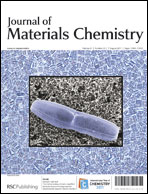The novel reporters, unimodal FT-IR-traceable, bimodal fluorescent and FT-IR-traceable hybrid silica (SiO2) nanoparticles (NPs), were prepared using the Stöber methodology. Initially, the basic Stöber co-hydrolysis of tetraethoxysilane (TEOS) and of the iron-complexed alkyl-triethoxysilane (EtO)3Si-L-(η4-2E,4E-dienyl)-Fe(CO)3(0) (L = alkyl linker, DIT-tag reagent 3) afforded unimodal 13.7 ± 2 nm-sized SiO2@DIT-tag60 NPs. These NPs can incorporate an organometallic FT-IR sensitive (η4-2E,4E-dienyl)-tricarbonyliron(0) complex moiety which acts as a sensitive FT-IR traceable species due to the strong iron complex νFeC![[triple bond, length as m-dash]](https://www.rsc.org/images/entities/char_e002.gif) O vibrational bands that appear in the 1996–2063 cm−1 region, a region free of any parasitic band. The sensitivity of the FT-IR-based detection ofSiO2@DIT-tag60 NPs has been determined using incremental mixtures of B16 melanoma cell lysates as a biological medium model. The detection limit was found to be 0.190 μg of Fe per mg of B16cell lysate. In the second step, bimodal hybrid fluorescent and FT-IR-traceable 35.7 ± 5 nm sized SiO2@DIT-tag20@FITC NPs were similarly fabricated, in order to enable both fluorescence and FT-IR spectroscopy detection. This has been readily obtained through the straightforward co-incorporation of an additional fluorescein-containing alkyl-triethoxysilane conjugate FITC–APTES (FITC: fluorescein isothiocyanate, APTES: (3-aminopropyl)triethoxysilane). Subsequent surface modification with APTES of the resulting SiO2@DIT-tag20@FITC NPs afforded amine functionalized 34.4 ± 6 nm-sized SiO2@DIT-tag20@FITC@NH2 NPs that were readily endocytosed by B16 melanoma cells. All these novel hybrid silica NPs have been fully characterized by FT-IR spectroscopy, high resolution TEM/SEM (HR-TEM/SEM) with elemental energy-dispersive X-ray spectroscopy (compositional EDAX analysis), dynamic light scattering (DLS), ζ potential measurements, and inductively coupled plasma-optical emission spectroscopy (ICP-OES). Preliminary biological studies demonstrated the non-toxicity of the NPs. No observable modification in the B16cells' morphology or mortality was seen after the internalization of SiO2@DIT-tag20@FITC@NH2 NPs.
O vibrational bands that appear in the 1996–2063 cm−1 region, a region free of any parasitic band. The sensitivity of the FT-IR-based detection ofSiO2@DIT-tag60 NPs has been determined using incremental mixtures of B16 melanoma cell lysates as a biological medium model. The detection limit was found to be 0.190 μg of Fe per mg of B16cell lysate. In the second step, bimodal hybrid fluorescent and FT-IR-traceable 35.7 ± 5 nm sized SiO2@DIT-tag20@FITC NPs were similarly fabricated, in order to enable both fluorescence and FT-IR spectroscopy detection. This has been readily obtained through the straightforward co-incorporation of an additional fluorescein-containing alkyl-triethoxysilane conjugate FITC–APTES (FITC: fluorescein isothiocyanate, APTES: (3-aminopropyl)triethoxysilane). Subsequent surface modification with APTES of the resulting SiO2@DIT-tag20@FITC NPs afforded amine functionalized 34.4 ± 6 nm-sized SiO2@DIT-tag20@FITC@NH2 NPs that were readily endocytosed by B16 melanoma cells. All these novel hybrid silica NPs have been fully characterized by FT-IR spectroscopy, high resolution TEM/SEM (HR-TEM/SEM) with elemental energy-dispersive X-ray spectroscopy (compositional EDAX analysis), dynamic light scattering (DLS), ζ potential measurements, and inductively coupled plasma-optical emission spectroscopy (ICP-OES). Preliminary biological studies demonstrated the non-toxicity of the NPs. No observable modification in the B16cells' morphology or mortality was seen after the internalization of SiO2@DIT-tag20@FITC@NH2 NPs.

You have access to this article
 Please wait while we load your content...
Something went wrong. Try again?
Please wait while we load your content...
Something went wrong. Try again?
![[triple bond, length as m-dash]](https://www.rsc.org/images/entities/char_e002.gif) O vibrational bands that appear in the 1996–2063 cm−1 region, a region free of any parasitic band. The sensitivity of the
O vibrational bands that appear in the 1996–2063 cm−1 region, a region free of any parasitic band. The sensitivity of the 

 Please wait while we load your content...
Please wait while we load your content...